Routes a call to an outbound destination number (B-party) with the capability of taking the call back and connecting the original caller (the A-party) to another destination (the C-party).
Take Back and Transfer
|
Routes a call to an outbound destination number (B-party) with the capability of taking the call back and connecting the original caller (the A-party) to another destination (the C-party). |

Use this when calls to a contact centre are regularly transferred to another contact centre.
The action cell also allows you to add the caller to a callback list so the system can call the customer back to offer them a customer survey via an automated OUTBOUND service. If callers are given the option to stay on the line following a call in order to complete the survey, they can be removed from the callback list once they have completed the survey.
This is for defining the initial call destination.
Number selection type
Select 'sequential', 'random', or 'weighted'.
Outbound address type
Select 'Number List' to build the list in the action cell. Or, select 'Delivery Point List' to use a preconfigured delivery point or delivery point group. A delivery point may be capped at a maximum number of simultaneous calls, typically corresponding to the number of agents who can take calls at that location. When allocating calls to delivery points, the system will call the first delivery point until the maximum number of simultaneous calls for that number is reached, and then proceed to the next in the list.
For a 'sequential or 'random' selection type, enter a number to route to in the Address field (or select a delivery point/group). The Call Data field optionally allows you to capture data for a call. To do this, populate the field with a local variable based on the Call Data system variable. Click Add to add the entry to the list below.
For a 'weighted' selection type, use the slider to select a percentage weighting for the number you are adding. A number assigned a 50% weighting will be tried twice as often as one assigned a 25% weighting, for example. The scale maximum reflects the percentage weight remaining as you add numbers.
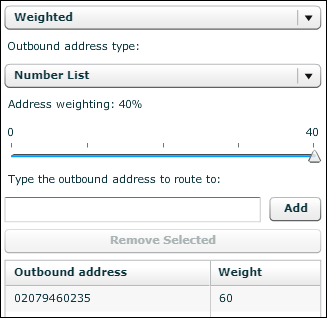
This is for configuring the audio prompts to play to the calling party (A-party) and called party (B-party) as the call is routed. It also includes general call-handling settings.
Media List
Select the media list containing the audio files to use for the audio prompts and then select the files. You can select a None check box to play a system default prompt instead of your own.
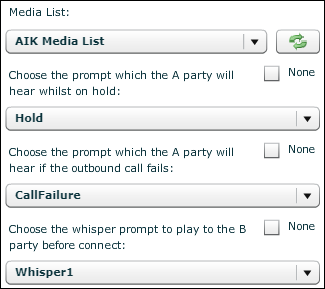
Call Timeout Period
Specify the period after which the service should deem the call routing attempt to have failed or the period after which it should attempt the next number in the list, if present.
Set Origination Number
Select the number to show to the called party.
Record Call
Select this to record calls. Call recording continues if the call is transferred.
Survey Call
Select this to include callers in a callback list and then complete the fields shown.
Use a Call Delay value to allow the current call to clear before initiating the callback. A Retry Delay value is the number of seconds that should elapse between each retry attempt. Use RedDial Service to select the name of the OUTBOUND script (of type 'Dial') to initiate the callback, launch the automated survey script, and manage retry attempts.
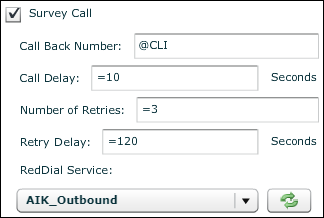
This is for configuring the audio prompts to play during a call transfer. It also includes general call-transfer settings.
Media List
Select the media list containing the audio files to use for the audio prompts and then select the files. You can select a None check box to play system default prompt instead of your own.
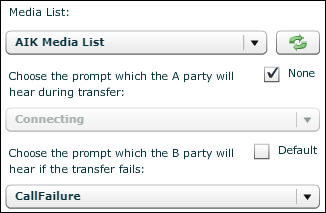
Call Timeout Period
Specify the period after which the service should deem the transfer attempt to have failed.
Set Origination Number
Select the number to show to the C-party.
Use Transfer code
Select this to allow the B-party to initiate a transfer using a transfer digit. Then, use the fields to specify the transfer digits to use. A cold transfer is a direct transfer to the C-party without consultation. A warm transfer is where the B-party speaks to the C-party asking if they want to take the call.
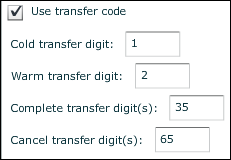
|
Exit point |
Taken |
|
After Successful Call |
After the call (including a transfer leg) has ended. |
|
After Failed Call |
If all attempts to route the initial outbound call failed. |